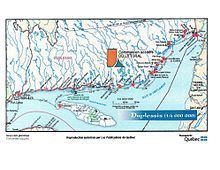 | ||
Charles lasnier co commission scolaire du littoral
The Commission scolaire du Littoral is a geographically-based school district in Canada. Situated along the Gulf of St. Lawrence, the School Board territory consists of nine Anglophone villages and four Francophone villages, scattered along 460 kilometers of coastline from Kegaska to Blanc-Sablon including Port-Menier (Anticosti Island). Their respective populations vary between 100 and 1000 inhabitants.
Contents
- Charles lasnier co commission scolaire du littoral
- Mission
- Vision and values
- Teaching establishments
- Territory
- History
- School Board Logo
- References
The School Board has a school enrolment of approximately 570 students annually. It offers general education services to the youth sector for pre-school, primary, and secondary levels as well as literacy and secondary general education sector to the Adult Education sector.
Mission
In respect to Article 207.1 of the Education Act and following the principle of equity and through the actions and commitment of its personnel, its establishments and its education stakeholders, the mission of the Commission scolaire du Littoral is to support its schools and centers in their quest to enable students to reach their full potential.
Vision and values
Following the principles of respect, equity, responsibility, transparency and perseverance, the Commission scolaire du Littoral aims at contributing to the development of qualified and independent citizens who are ready to integrate the society and contribute in the growth and sustainability of the communities of the Lower North Shore and Anticosti.
Teaching establishments
Primary and secondary schools: 12
Adult education centers: 14
Territory
History
On April 14, 1967, the National Assembly of the Province of Québec sanctioned Bill 41, instituting the "Commission scolaire de la Côte-Nord du Golfe St-Laurent". This school board, directed by an administrator, would become responsible for education in fifteen communities. These communities spread out from Kegaska to Blanc Sablon, a territory of 460 kilometers that is not connected to the Québec Provincial road network. Bill 41, created the first "unified" school board in the Province of Québec, serving a French, English, and Native population of Catholic and Protestant religion and giving courses from Kindergarten to Secondary inclusively.
On June 18, 1975, the name of the Commission scolaire de la Côte-Nord du Golfe St-Laurent was changed by order in council for the Commission scolaire du Littoral.
The territory of Anticosti Island was added to the Commission scolaire du Littoral with Bill 48 which was passed on June 18, 1976.
Following inter-governmental agreements, the Natives acquired their school autonomy on the St. Augustine River Reservation on July 1, 1990, and on the La Romaine Reserve on July 1, 1991. However, the school board maintained services in these two communities so as to serve the non-Indian population.
The School Board holds a special status considering it is managed by an administrator (who is named by the Lieutenant Governor in Council) who replaces the school commissioners and the director general. He exercises his powers by means of ordinances, of which a copy is automatically transmitted to the Minister who decides to accept it or to reject it in whole or in part.
Moreover, the Commission scolaire du Littoral is characterized by the fact that it is not classified as a linguistic school board.
School Board Logo
Orange represents the soil and the warmth of the people it serves. Turquoise (blue-green) represents the sea that is omnipresent on the territory. < The vertical features imitate the territory and its vastness. The triangle represents Anticosti Island and the motion of the waves, reminding us of our motto "We extend the horizons of knowledge, against all winds and tides..." The whole forms an "L" for Littoral.
